Just last week, Night School Studio put out Afterparty on the Switch, a release that we absolutely loved. The follow up to 2016's Oxenfree proves itself to be a worthy successor, mixing a darkly humorous story with a cutting edge focus on directly marrying cutscenes with gameplay.
Given that Afterparty in many ways stands out uniquely among most releases on the eShop right now, we thought it'd be interesting to have a chat with some of the talent behind the release and gain some insights into what production was like. We got the chance to talk with none other than Sean Krankel--one of the co-founders of the studio--and heard plenty of interesting details about the studio's underlying philosophy, scrapped games and ideas that didn't make it in to the full release, and even a little bit about what could come next for Night School.
NL: For anyone who isn’t familiar with Afterparty, tell us a little bit about the setting and what kind of game it is.
Sean Krankel: Afterparty is a game that is sort of a mix between a buddy adventure and a comedy where you play as two characters named Milo and Lola who are early twenty-something. They’re just about to embark on what appeared to be pretty promising lives when they die horribly and find out they are in hell, though we don’t really know why just yet. As they’re about to get processed in hell, sort of like going to the DMV to get your driver’s license, they find out that there is a loophole where if you can get invited to Satan’s house party and outdrink Satan, he will grant you re-entry to Earth. This very rarely happened, maybe only once in eons, it’s basically an impossible feat. But, for the player, the game is a bit like mixing Superbad and Beetlejuice together on this pub crawl through hell.
the game is a bit like mixing Superbad and Beetlejuice together on this pub crawl through hell.
Your team is comprised of both some Ex-Disney and Telltale staff, so what lessons from there would you say influenced the development of Afterparty?
I think we have a pretty diverse set of people who want you to interact with story in new ways. Looking at both our Disney and Telltale backgrounds, the idea of merging story with gameplay mechanics has been something that’s really compelling to us. Prior to Oxenfree, most story games had you interacting with a cutscene and that cutscene would maybe have some branching dialogue then you’d go back to gameplay and it sort of became this endless back and forth between gameplay and story. We wanted to see how we could make those two elements the exact same thing. How do we make those two the exact same thing? How do we build a game that doesn’t ever take control away from the player? Something that empowers you to behave in this world however you want to and have the agency to change the story in a way that other games couldn’t deliver.
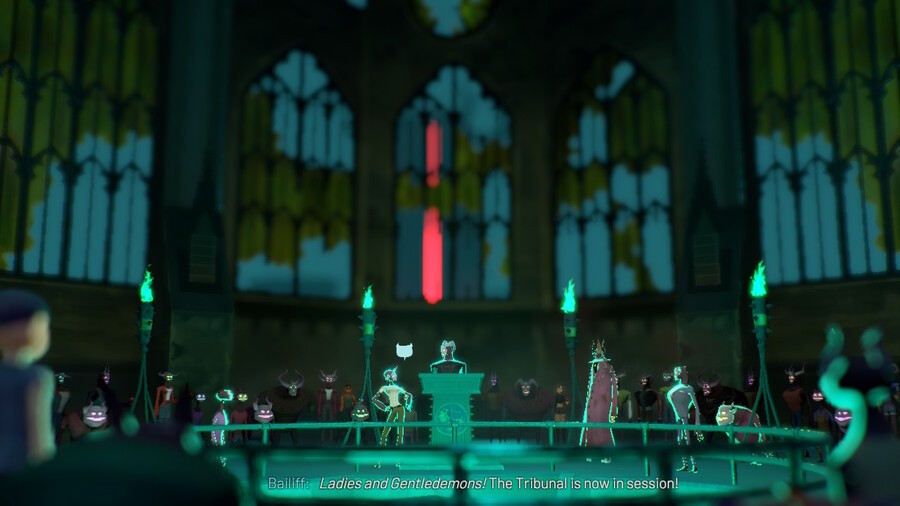
I’m one of the ex-Disney folks, and for me, what we tried to imbue in this studio is a really heavy worldbuilding focus. Trying to find ways where we’ve got really relatable characters and worlds that are also built into really fantastical environments. Situations that are easy to understand without being much into games themselves would ideally be the kind of experience we want to deliver. “Party your way out of hell” is hopefully a premise that anybody can ‘get’. From the Telltale side, there was so much the team wanted to build on from what Telltale used to do. They were the best-in-class narrative company, but the gameplay and that delineation between gameplay and cutscenes was something we thought we could improve on. Specifically for Afterparty, we took the free-flowing dialogue system that we had in Oxenfree and then built on top of that by making different drinks that could unlock whole new branches to dialogue and personalities. It really was a matter of how we make the game an extension of what you want to say and do and ideally never really make you feel limited or that there’s a ‘right or wrong’ choice. It should feel more like a personality test, not a matter of what we as the developers want to make you do.
It really was a matter of how we make the game an extension of what you want to say and do
Was it always the plan from the beginning to follow up Oxenfree with a similarly narrative focused title?
In short, no. We knew that we wanted to continue down this road of narrative, but we didn’t know if we’d use similar mechanics or what we’d keep from Oxenfree versus what we’d leave behind. Once Oxenfree came out and we saw how the audience reacted to Alex (the main protagonist), specifically how they were able to really define Alex as their own, we thought that it would be sort of foolish to leave behind the things that were working well for us. So, all that said, we want to put a pretty big spin on what Oxenfree had done. I think tonally we landed in a pretty different space, where this one is more of a comedic buddy adventure and Oxenfree is more of a supernatural thriller.
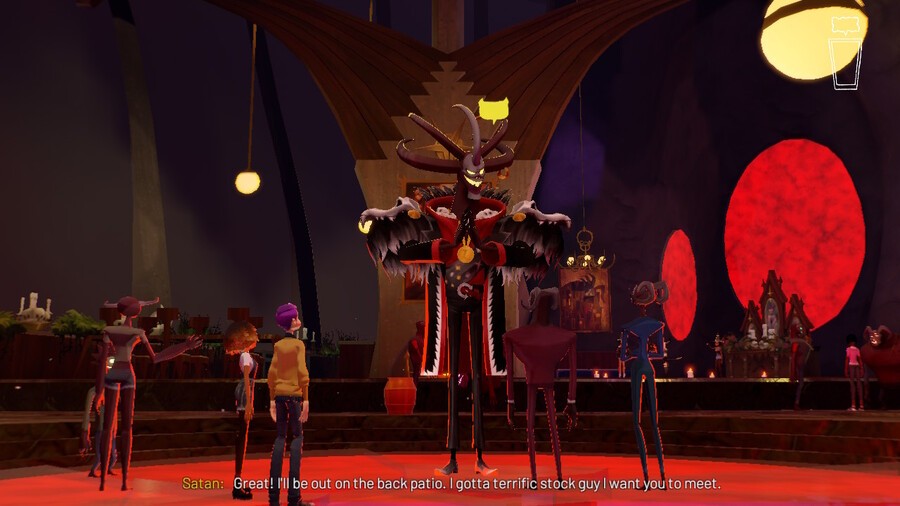
I think there’s a lot of heart and a lot of the same themes of coming of age that exist in both games. Oxenfree explored the concept of how we make you feel like an underpowered character in a pretty supernatural situation, while in Afterparty we wanted to see what would happen where you could play as two characters and play with all the things you’d expect out of buddy movies but now make it playable. In the beginning, Milo and Lola feel like they’re almost symbiotically connected and then—without spoiling anything—over the course of the story you really start to see the push and pull of what this long term friendship looks like and we manifest that in ways such as how we branch the story and how gameplay mechanics work. We’re always trying to find ways to switch up what you would expect. I think I’d say we knew we didn’t want to do a ‘spooky’ game, but we did know that we wanted to do something rooted in story and new ways to interact with it.
Did you have to leave any story or gameplay ideas on the cutting room floor? If so, what were they?
Yes, definitely. In Afterparty, I think one of the things that ended up not being the right fit even though we still found it compelling was the dynamic interactions with the drinks that would introduce more risk and reward for what you drink. We had a version where you had to worry about puking, about blacking out and waking up in a new environment, but the more we designed all those things out and tested them, we discovered that none of it was actually fun. It was actually kind of depressing and weird. We then pivoted to treat drinks in the game more like Harry Potter-esque potions, making it more about creating new dialogue branches and less about resource management. Other than that there wasn’t a lot we left behind. I think we started with an even bigger game than what we made, which is already significantly more than Oxenfree. I think any cuts along the way were more about improving the focus of Afterparty and I think they were ultimately the right call.
We had a version where you had to worry about puking, about blacking out and waking up in a new environment
What were some big challenges in the development cycle for Afterparty?
We had quite a few, all of them came from our eyes being bigger than our stomachs. One of the big ones was having a world that was now populated with up to thirty or forty characters on screen at once. In Oxenfree, we had at most four or five characters on screen, while Afterparty has you going through urban environments and bars with all these characters that have their own pathfinding and conversations. There were a lot of challenges in terms of how those scenes are set up. Additionally, with the art style, we decided to move to a more 3D approach in terms of how our art was generated. In Oxenfree, all the backgrounds were 2D while the characters were 3D, but Afterparty had everything in 3D.
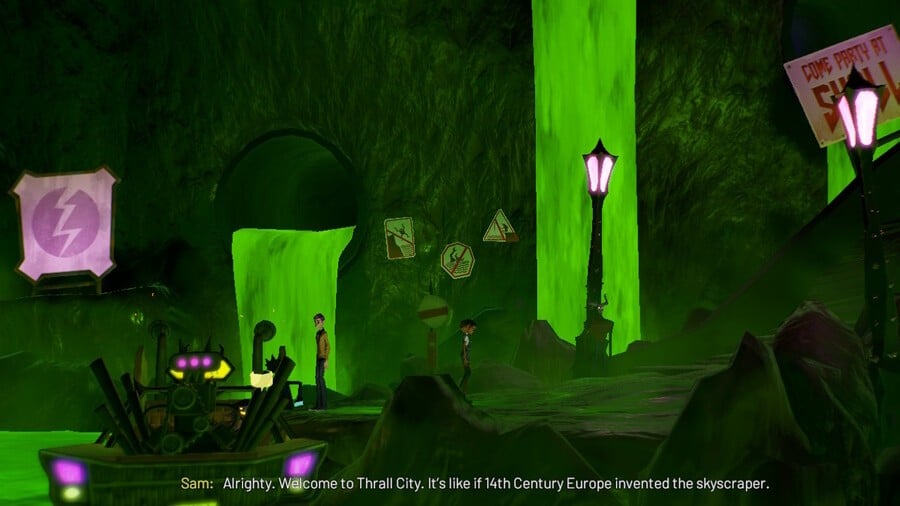
We really had to beef up the size of the team, but not so much that we couldn’t afford to make the game, so we had to find clever ways to mix 2D and 3D assets to get this all 3D look in place. In addition to that, having a larger cast meant having a larger cast of voice actors. We were working with the schedules of quite a few different actors and all of them fortunately did incredible work and we were lucky to have people who wanted to continue working with us after Oxenfree. So, the talent was great, but we had over three hundred character models and upwards of thirty actors whereas Oxenfree was five actors. To sum it up, I’d say scale and scope were the big challenges; we wanted to make something that felt more or less like an R-rated Pixar movie but with a pretty small team working on it.
What was the script writing process like for Afterparty?
All credit due to the writing team here! The lead writer on the script is Adam Hines, my cousin and co-founder of the studio. Adam wrote all of Oxenfree, but with Afterparty we ended up growing the team and added three other writers, all of which were ex-Telltale folks or have a background in animation. There were new challenges here in terms of having a team of writers versus one, singular writer working on it, but the benefit of it was that we could move away from the “playable movie” design of Oxenfree and structure it more like Rick and Morty or Bojack Horseman or The Simpsons where there’s a consistent arc, but inside of that each of the quests can feel more like episodes. You can follow a specific set of characters for twenty to thirty minutes and they’re wildly different than the characters you’ll meet in the next segment. So, it was kind of cool to let the writers each flex on a per-quest basis, all of which happened under the oversight of Adam.
I think the script came in at maybe 110,000 words; about the size of many movie scripts.
One of the things we did very early on to ensure things didn’t feel too scattershot was defining the journey for Milo and Lola and what we wanted to see from them. The story is ultimately about their long-term friendship and the challenges that come with that. All the quests are designed to tease and pull out different aspects of those bigger story beats.
Early on, we decided on the five or six endings that we want players to see, we knew that these had the core themes of what you’d want to see out of this kind of story and by the end of the second act we’re really digging deeper into their friendship. So, once all that was in place and we knew where we wanted their friendship to be by the ending(s), then we were able to set all the writers out to fill in the gaps with their own ideas for the quests. I definitely don’t want to oversimplify it, though. It is a massive balancing act for the writers to go between telling a great story and give narrative agency to players while unspooling this spaghetti ball of writing. I think the script came in at maybe 110,000 words; about the size of many movie scripts. Having one main writer at the head of that really helps.
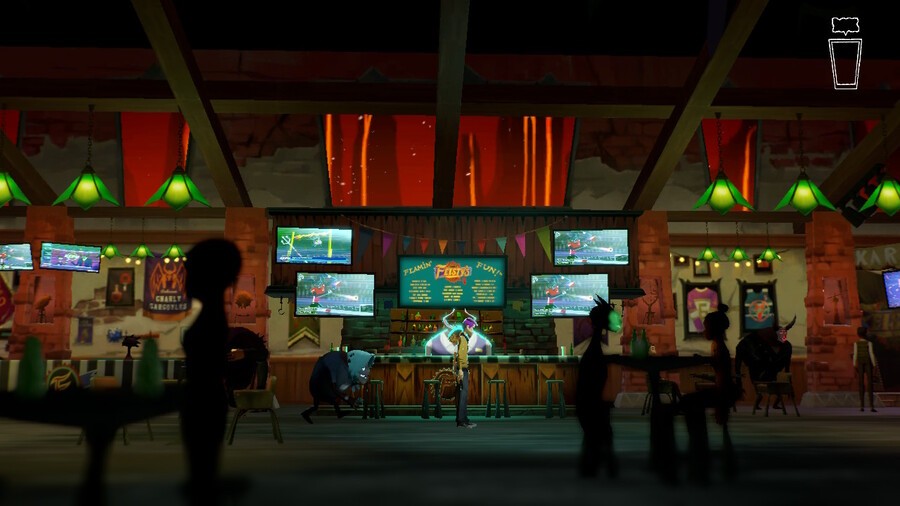
If any, what major inspiration (books, movies, etc.) or influences were you drawing on as you were writing this out?
We wanted players to laugh and feel like these characters were relatable, but dealing with almost unrelatable, larger than life circumstances. So, we looked at a lot of Edgar Wright movies, Beetlejuice, Superbad, Bill and Ted’s Excellent Adventure, all these things that center on the meaty relationships between best friends that’s getting kind of bounced around by an outside world. Making a sort of playable version of those kinds of movies was appealing to us early on. When it comes to the lore, though, I think Adam and the team had a lot of fun because we treated this world as if every religion is correct. Nothing is off limits in that regard, so when it was appropriate we’d borrow from, say, the Bible, while in other cases we’d borrow from fictional religious texts or other philosophies that many hold dear. It was always about finding ways to apply the themes of our story to all those versions and perspectives on the afterlife. So, the inspiration was an interesting mix of these low-brow movies and some lofty religious subtext for the world you wander.
What was the recording process like?
It varied! Most of the actors were local, fortunately, and with our studio being in LA, most actors either live nearby or come through pretty regularly. We already had a great recording studio that we worked with on Oxenfree and a lot of that process was sorted out from our previous experience. The challenging part came from the script going through various rewrites and branches. It’s hard to keep getting talent back in and have a lot of busy actors with overlapping schedules working together to hit the deadlines we want.
The other thing on top of that, specifically for Milo and Lola, had to do with how many drinks you can have. In any given bar, there are up to five different personality types you can go with based on both the drinks and the standard choices. So, getting the actors in the right mood to, say, talk as a pirate for one line read and then talk like a mobster or tell bad vaudevillian jokes for another made for quite the pendulum swing. In Oxenfree, most of the tone was pretty consistent. But Afterparty, being a comedy, was all over the place with the wild array of drinks and how it all has to still be funny to a degree. In that respect, the directing was a lot more interesting, and then the schedules are crazy when you’ve got all these busy actors to juggle.
getting the actors in the right mood to, say, talk as a pirate for one
line read and then talk like a mobster or tell bad vaudevillian jokes
for another made for quite the pendulum swing.
How did you come up with all the different drink effects?
It was fun! We actually did a little pub crawl ourselves and that didn’t end all too well, so we stopped doing those! The magic ‘aha!’ moment for us was when we recognized that we could use drinks to reflect a cartoonish style of personality. Originally, we thought the drinks would just closely mirror how we all behave in real life. For example, one would make you a little flirtier while another would make you more aggressive. But, the further we got in, the more we recognized that we could heavily theme these drinks and have the themes apply to different puzzles and challenges. Moreover, we could make some seriously outlandish drinks! At its core, the drink system is a reflection of someone going out and saying “it’s gonna be a tequila night, because I want to party!” We wanted to amp that up, and that bled into how we developed things like locations and storylines. Oxenfree was like a relatively normal world being hit with these strange, larger than life circumstances, but in Afterparty it’s more like the whole world can be kind of like an R-rated Pixar world. We can have the characters go to a three story, crazed demon S&M bar and make lots of jokes around that, or we can deal with fairly dark things but because of the ridiculous setting, we can be pretty on the nose about it. So, the drinks lended themselves to that well; they’re ridiculous in concept and make people want to experiment further.

It’s our understanding that during production for Afterparty, your team was concurrently producing a Stranger Things spin-off that never saw the light of day due to the fall of Telltale Games. What happened with what was left over from that? If any, what ideas or concepts you were going to explore with that release would you like to revisit?
That’s a great question. I’ve never publicly confirmed or denied this, but I will say that we were working on a game like that and it’s just sort of… gone now. Like, there’s a version of this game that exists and is incomplete, and after Telltale folded, so did that game. There were some things we’d like to revisit, too. I won’t go super specific into the details, but I will say that one of the things we want to keep pushing into is how we can branch story in ways that aren’t just dialogue. Whereas in Oxenfree it was almost one hundred percent just dialogue, and in Afterparty it was dialogue, drinks, and some of the activities and minigames. In the Stranger Things game, we were playing with a lot more ways to branch story based on action, time of day, and a bunch of other things. It was a very cool project, and I think those concepts will make their way into what we’re looking to do next.
I’ve never publicly confirmed or denied this, but I will say that we
were working on a game like that and it’s just sort of… gone now.
For the next game, do you want to do another narrative-focused release such as Afterparty and Oxenfree? If not, what are some other genres you’d like to explore?
At the core of whatever we do, storytelling will always be present. What I mean by that is that you’ll have a character going through some sort of an arc and have interesting interactions with other characters and ideally the player would have plenty of agency in that. That said, I don’t think we’re necessarily fully married to using the same dialogue system again, or using the same camera perspectives. There’s a lot of ideas being tossed around now internally as we’re in the discovery phase of what’s coming next that includes a lot of new ways to interact with the game world. It’s highly unlikely we’ll ever move away from narrative then, or into something like a multiplayer sports product or anything like that.
The other thing is that we’d like to explore new genres and tones just from a narrative perspective, a bit like the shift from Oxenfree to Afterparty. Not to say that we want to sway wildly between concepts, but why not do a romantic comedy or a heist game? There’s a whole world of other story types out there that would benefit from a player-driven narrative. There’s even ideas for how we could explore character from Oxenfree or Afterparty again. We’re so early on concepting for everything that we don’t want to kick anything off until we have a good reason for the “how?”, we want to make sure that we push our mechanics forward before we make any big decisions. So, there’s a guarantee that our mechanics will move forward or into new directions, but the genre is still very much up in the air.
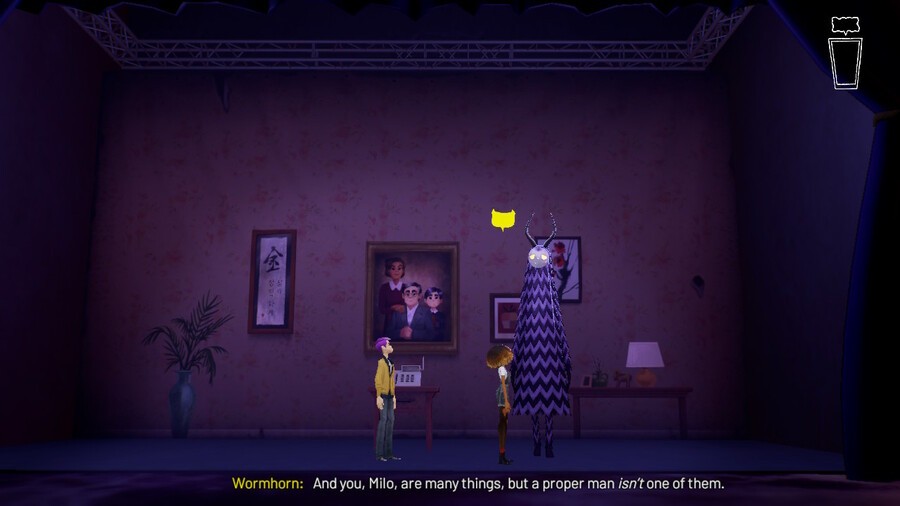
What are some key takeaways you’ve had from the critical and commercial reception to Afterparty?
We were pleasantly surprised with how much people connected with the story and characters. I think it’s a difficult game to sell if you don’t immediately connect with the high concept. People that play the game realize that there are many layers to it. Yes, there’s comedic and adventure aspects, but there’s a story with a ton of heart and a lot of player agency. It’s been nice to see that people connect with that, because if the characters or the world weren’t compelling, the whole game wouldn’t be either.
Another thing is how it’s always surprising when people don’t see the work that went into something. There are certain things we spent months laboring over and freaking out about that nobody has even noticed. I’m not going to say what those things are because I’m looking forward to people finding out about them! The flipside, then, is people think they’re seeing things and they’re not. They’ll expect an easter egg, or that this is connecting the dots to some larger ARG or with Oxenfree, and there’s not necessarily a lot of that here. It’s fun to watch people unpack it themselves in that regard, I’ve enjoyed getting some distance from the game and seeing what people fall in love with. When you ship it, it’s hard to not just view the game as a lot of effort from the last two years, but it’s nice to watch people interact with it just for what it is. Over the course of the next year or two, we still plan on a lot of support for Afterparty in bringing it to new platforms and perhaps even some additional content.
I’ve enjoyed getting some distance from the game and seeing what people fall in love with.
Without giving away too much, what are some ideas you've got for additional content?
All I would say is that the early thoughts center around what would be essentially more ‘episodes’ set in the world. What we’d really want to play with is who you’d play as and what your goals are. It might not be exactly Milo and Lola again. Maybe it’s somebody else. We want to make sure there’s a reason for additional content to exist, we don’t just want to pump out some random DLC. But, there have already been some really interesting ideas internally that people are really starting to rally around. So, definitely not confirmed, but this is a fun time post-shipping where we’re deciding on what to focus on next. Is it brand new stuff? Is it continuing to build out some of the worlds we’ve already made? I think it’ll be a little bit of both.
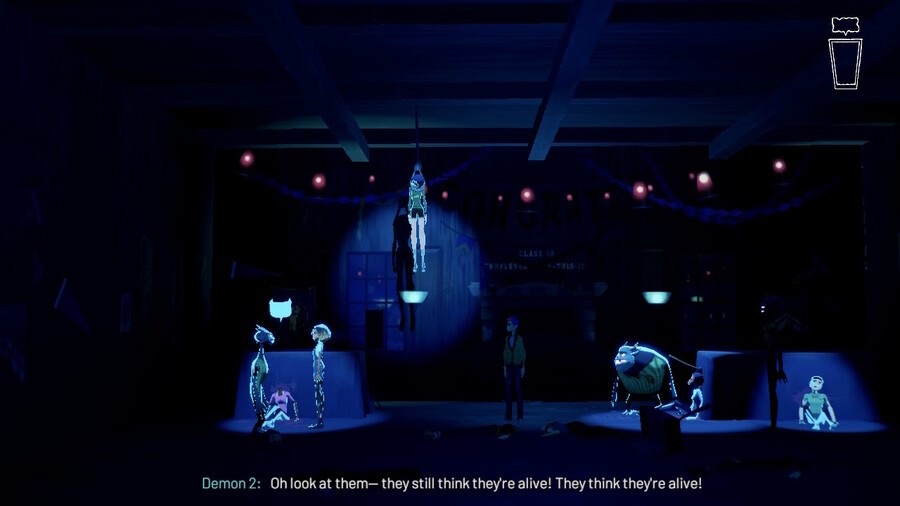
Finally, what games have you been playing lately?
I am about forty hours into Dragon Quest XI! I did not expect to get that into that game, I don’t even play JRPG’s. But, something has just gripped me with that game, I think part of it has to do with my seven-year-old daughter. She’s just obsessed with the world and can play it pretty easily. So, Dragon Quest has just consumed me on Switch, on other platforms I’ve been working with Jedi: Fallen Order and Death Stranding. I’m going to keep plodding through Dragon Quest until Animal Crossing and DOOM come out!
Our thanks to Sean for taking the time to answer our questions. We look forward to the next major project from Night School Studio. In the meantime, feel free to share your thoughts on Afterparty and your favorite drinks from it in the comments below. And if you haven't gotten around to downloading it yet, what are you waiting for?





Comments 11
Oxenfree was not a bad game. The pacing was slow and linear, but it was alright.
This sort of looks like my style, as I am a fan the more "extraterrestrial" influenced styles.
Good interview. Really excited for what they do next. Pretty safe to say they knocked it out of the park on both of their first two projects.
Why am I only just now hearing about this? Gonna take a look when I get off as I liked Oxenfree. ó.ô The style has my attention, too.
I’ve just starting playing this and already think it’s fantastic. Hearing they are ex Disney and tell tale explains a lot. The humour is right up my street and just the tonic considering everything going on in the real world right now, really can’t wait to get properly stuck in.
NintendoLife, could you please offer us more articles like this? Lately, most of your articles consist of irrelevant findings from Twitter. I have noticed that a site called "Nintendo Everything" which -although not 100% sure- is run by just one man from the USA offers way more informative and interesting articles than you do.
Could you please set as a goal for every article you publish from now on to be an exceptional one and offer more overall quality like you used to a couple of years ago?
Thank you for reading my message.
Oxenfree is one of my favourite games of all time. It caught me totally by surprise and I am SOOOOO happy to see this!
I had no idea it was coming!
I was obsessed with Oxenfree for like 6 months. I’m trying to get my significant other to commit to playing Afterparty with me, but we are struggling
@Cosats Tells a bit about the current state of the world, in my opinion. Even escapades are becoming virtual.
@Kabloop +1, probably not every article can be like this, but at least NL can/should make an effort to publish more articles like this.
From the article and comments and general coverage around this game, this one seems dope, planning to purchase it soon.
I got afterparty last week but not played it yet. I am expecting far less ambitious dialogue options than suggested in this interview. Was going to try pairing each in-game drink with a real one as I play it. Good way of staying in during the viral pandemic.
A game about drinking? Nah not for me.
Binged through the game in one sitting for about 6 hours last night from 8 PM to 2 AM. Given the theme of a drunken night out it felt like a very appropriate way to experience this. I thoroughly enjoyed my experience and am looking forward to a second playthrough since it seems like this game actually follows through on its idea of multiple ways to get through, which is something the telltale games tend to lack.
Tap here to load 11 comments
Leave A Comment
Hold on there, you need to login to post a comment...